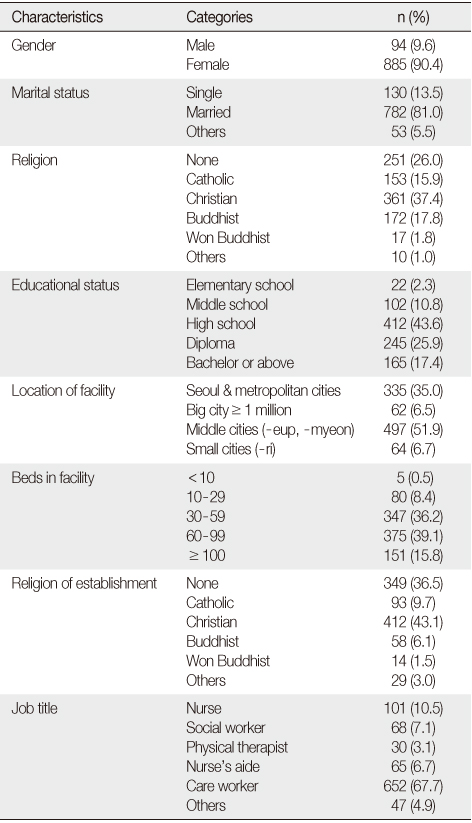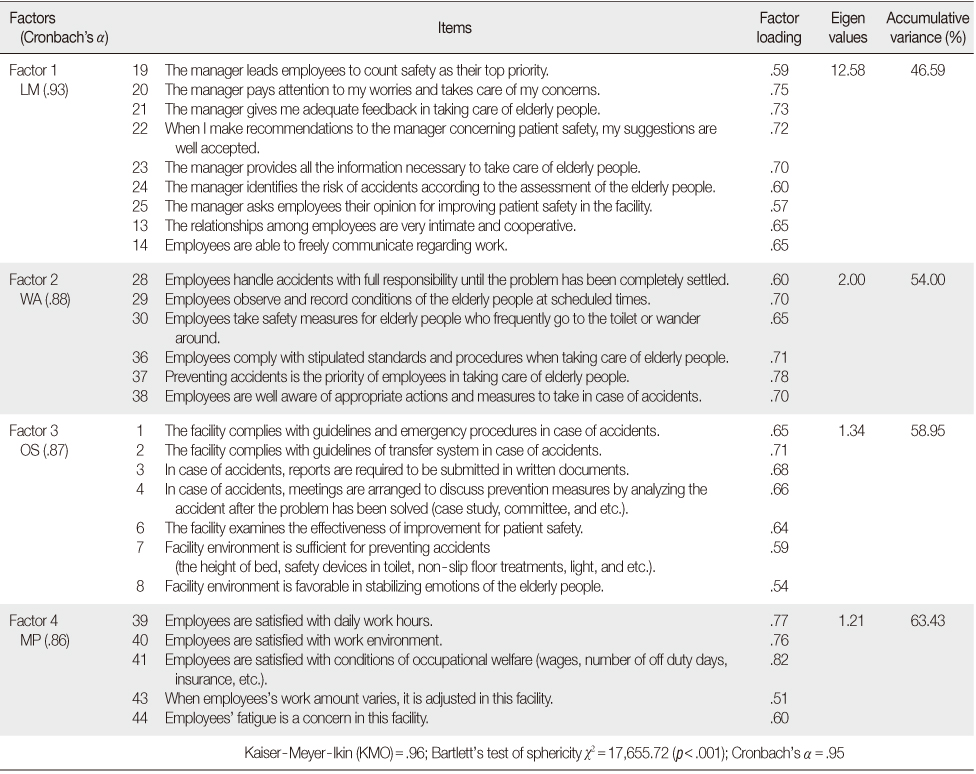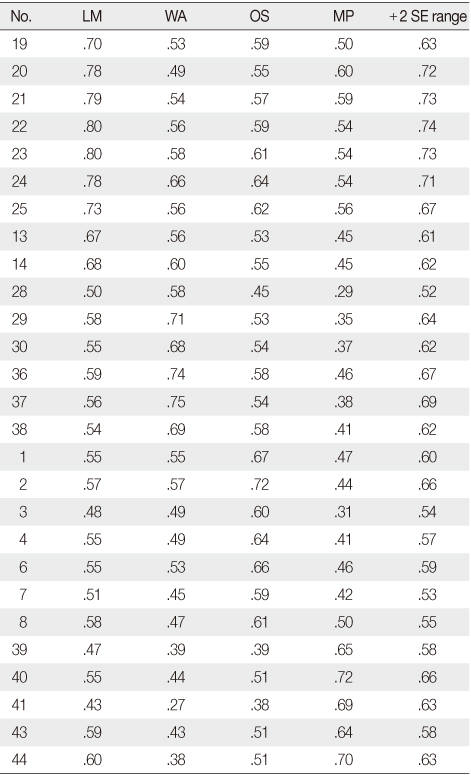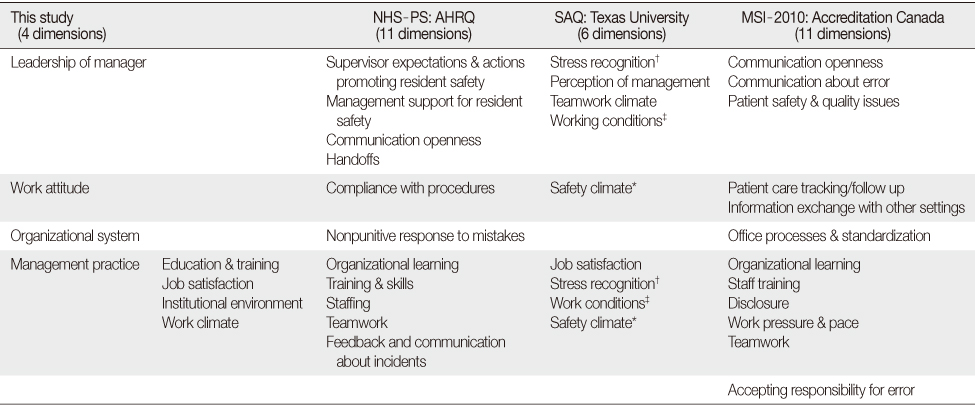Articles
- Page Path
- HOME > J Korean Acad Nurs > Volume 43(3); 2013 > Article
-
Original Article
- Development and Validation of the Korean Patient Safety Culture Scale for Nursing Homes
- Sook Hee Yoon, Byungsoo Kim, Se Young Kim
-
Journal of Korean Academy of Nursing 2013;43(3):379-388.
DOI: https://doi.org/10.4040/jkan.2013.43.3.379
Published online: June 28, 2013
1Department of Nursing, Institute of Health Science, Inje University, Busan, Korea.
2Department of Data Science, Institute of Statistical Information, Inje University, Gimhae, Korea.
3Department of Nursing, Mokpo National University, Muan-gun, Korea.
- Address reprint requests to: Kim, Se Young. Department of Nursing, Mokpo National University, 1666 Yeongsan-ro, Cheonggye-myeon, Muan-gun 534-729, Korea. Tel: +82-42-259-1718, Fax: +82-42-259-1709, sarakimk@eulji.ac.kr
© 2013 Korean Society of Nursing Science
Abstract
-
Purpose
- The purpose of this study was to develop a tool to evaluate patient safety culture in nursing homes and to test its validity and reliability.
-
Methods
- A preliminary tool was developed through interviews with focus group, content validity tests, and a pilot study. A nationwide survey was conducted from February to April, 2011, using self-report questionnaires. Participants were 982 employees in nursing homes. Data were analyzed using Cronbach's alpha, item analysis, factor analysis, and multitrait/multi-Item analysis.
-
Results
- From the results of the analysis, 27 final items were selected from 49 items on the preliminary tool. Items with low correlation with total scale were excluded. The 4 factors sorted by factor analysis contributed 63.4% of the variance in the total scale. The factors were labeled as leadership, organizational system, working attitude, management practice. Cronbach's alpha for internal consistency was .95 and the range for the 4 factors was from .86 to .93.
-
Conclusion
- The results of this study indicate that the Korean Patient Safety Culture Scale has reliability and validity and is suitable for evaluation of patient safety culture in Korean nursing homes.
- 1. Accreditation Canada. Canadian health accreditation report. 2010;Retrieved January 31, 2010. from http://www.accreditation.ca/en/content.aspx?pageid=84&terms=2010+Canadian+health+Accreditation+report
- 2. Agency for Healthcare Research and Quality. Nursing home surveys on patient safety culture. 2008;Retrieved May 9, 2012. from http://www.ahrq.gov/professionals/quality-patient-safety/patient-safety-culture/nursing-home/index.html
- 3. Bonner AF, Castle NG, Perera S, Handler SM. Patient safety culture: A review of the nursing home literature and recommendations for practice. Ann Longterm Care. 2008;16(3):18–22.PubMedPMC
- 4. Castle NG. Nurse aides' ratings of the resident safety culture in nursing homes. Int J Qual Health Care. 2006;18(5):370–376. http://dx.doi.org/10.1093/intqhc/mzl038ArticlePubMed
- 5. Castle NG, Sonon KE. A culture of patient safety in nursing homes. Qual Saf Health Care. 2006;15(6):405–408. http://dx.doi.org/10.1136/qshc.2006.018424ArticlePubMedPMC
- 6. Colla JB, Bracken AC, Kinney LM, Weeks WB. Measuring patient safety climate: a review of surveys. Qual Saf Health Care. 2005;14(5):364–366. http://dx.doi.org/10.1136/qshc.2005.014217ArticlePubMedPMC
- 7. Committee on Quality of Health Care in America, & Institute of Medicine. Crossing the quality chasm: A new health system for the 21st century. Washington, DC: National Academy Press; 2001.
- 8. Cooper JB. Developing a culture of safety. Biomed Instrum Technol. 2003;37(3):212–214.PubMed
- 9. Feng X, Bobay K, Weiss M. Patient safety culture in nursing: Adimensional concept analysis. J Adv Nurs. 2008;63(3):310–319. http://dx.doi.org/10.1111/j.1365-2648.2008.04728.xArticlePubMed
- 10. Flin R, Yule S. Leadership for safety: Industrial experience. Qual Saf Health Care. 2004;13:Suppl 2. ii45–ii51. http://dx.doi.org/10.1136/qhc.13.suppl_2.ii45ArticlePubMedPMC
- 11. Handler SM, Castle NG, Studenski SA, Perera S, Fridsma DB, Nace DA, et al. Patient safety culture assessment in the nursing home. Qual Saf Health Care. 2006;15(6):400–404. http://dx.doi.org/10.1136/qshc.2006.018408ArticlePubMedPMC
- 12. Havens DS, Aiken LH. Shaping systems to promote desired outcomes. The magnet hospital model. J Nurs Adm. 1999;29(2):14–20.
- 13. Health and Safety Commission. Organizing for safety: Third report of the human factors study group of ACSNI. Sudbury, UK: HSE Books; 1993.
- 14. Hughes CM, Lapane KL. Nurses' and nursing assistants' perceptions of patient safety culture in nursing homes. Int J Qual Health Care. 2006;18(4):281–286. http://dx.doi.org/10.1093/intqhc/mzl020ArticlePubMed
- 15. Jeong J, Seo YJ, Nam EW. Factors affecting patient safety management activities at nursing divisions of two university hospitals. Korean J Hosp Manage. 2006;11(1):91–109.
- 16. Jeong KH. The status of caregiving for frail older persons and family caregiving burden. Health Welf Policy Forum. 2002;66:17–31.
- 17. Kim JE, Kang MA, An KE, Sung YH. A survey of nurses' perception of patient safety related to hospital culture and reports of medical errors. Clin Nurs Res. 2007;13(3):169–179.
- 18. Kim JS, Oh HY. Perceptions and attitude on use of physical restraints among caregivers in long term care facilities. J Korean Gerontol Soc. 2006;26(2):347–360.
- 19. Kim M. The effectiveness of error reporting promoting strategy on nurse's attitude, patient safety culture, intention to report and reporting rate. J Korean Acad Nurs. 2010;40(2):172–181. http://dx.doi.org/10.4040/jkan.2010.40.2.172ArticlePubMed
- 20. Kim MC, Cho H, Sunwoo S, Kim SW, Cho HJ. Prevalence and associated factors of fall among the elderly in nursing home. J Korean Geriatr Soc. 1999;3(4):29–38.
- 21. Krumberger JM. Building a culture of safety. RN. 2001;64(1):32ac2–32ac3.PubMed
- 22. National Health Insurance. Long-term care facilities. 2013;Retrieved March 18, 2013. from http://www.longtermcare.or.kr/portal/site/nydev/MENUITEM_ORGSEARCH/
- 23. Nieva VF, Sorra J. Safety culture assessment: A tool for improving patient safety in healthcare organizations. Qual Saf Health Care. 2003;12:Suppl 2. ii17–ii23.ArticlePubMedPMC
- 24. Sexton JB, Helmreich RL, Neilands TB, Rowan K, Vella K, Boyden J, et al. The safety attitudes questionnaire: Psychometric properties, benchmarking data, and emerging research. BMC Health Serv Res. 2006;6:44. http://dx.doi.org/10.1186/1472-6963-6-44ArticlePubMedPMCPDF
- 25. Tabachnick BG, Fidell LS. Using multivariate statistics. Needham Heights, MA: Allyn & Bacon, Inc; 2006.
- 26. Ware JE Jr, Gandek B. Methods for testing data quality, scaling assumptions, and reliability: The IQOLA project approach. International quality of life assessment. J Clin Epidemiol. 1998;51(11):945–952.PubMed
- 27. Ware JE, Snow KK, Kosinski M, Gandek B. SF-36 health survey: Manual and institute. Boston, MA: The Health Institute, New England Medical Center; 1993.
- 28. Wisniewski AM, Erdley WS, Singh R, Servoss TJ, Naughton BJ, Singh G. Assessment of safety attitudes in a skilled nursing facility. Geriatr Nurs. 2007;28(2):126–136. http://dx.doi.org/10.1016/j.gerinurse.2007.01.001ArticlePubMed
- 29. Yoon SH, Wu X. Content analysis of patient safety culture in nursing homes. J Korean Acad Nurs Adm. 2013;19(1):118–127. http://dx.doi.org/10.11111/jkana.2013.19.1.118Article
REFERENCES
Figure & Data
REFERENCES
Citations

- Factors Associated With Registered Nurses’ Safety Nursing Activities in Nursing Homes
Jiyeon Lee, Sunyeob Choi
Asian Nursing Research.2025; 19(1): 19. CrossRef - Factors Associated with the Patient Safety Activities among Home-Visit Caregiver: A Cross-Sectional Study
Soon-hee Cho, Sujin Kang, Youngji Kim
Annals of Geriatric Medicine and Research.2025; 29(2): 159. CrossRef - Institutional factors affecting patient safety culture and resident safety activities in long-term care facilities
Deulle Min
Geriatric Nursing.2025; 65: 103520. CrossRef - Development and validation of the resident safety activity questionnaire for long-term care facility staff
Deulle Min, Suhee Kim
Geriatric Nursing.2024; 56: 278. CrossRef - The mediating effect of patient safety culture on the relationship between professionalism, self-leadership, and compliance with infection prevention activity against emerging respiratory infectious disease among nurses working in geriatric long-term care
Sun Young Jeong, Min Sun Song, Heeja Jung
Journal of Korean Gerontological Nursing.2024; 26(4): 360. CrossRef - Study of Patient Safety Culture Awareness of Radiological Technologists in Magnetic Resonance Imaging Laboratories
Min-Seo Park, Dong-Ha Lee, Hyun-Jin Jo, Hea-Youn Cho, Yeong-Cheol Heo
Journal of the Korean Society of MR Technology.2024; 34(1): 9. CrossRef - Developing a Cross-National Disability Measure for Older Adult Populations across Korea, China, and Japan
Sanghun Nam, Mi Jung Lee, Ickpyo Hong
International Journal of Environmental Research and Public Health.2022; 19(16): 10338. CrossRef - Patient safety measurement tools used in nursing homes: a systematic literature review
Kyoung-A Kim, Jungeun Lee, Dahee Kim, Deulle Min
BMC Health Services Research.2022;[Epub] CrossRef - Influence of Communication Self-efficacy and Perception of Patient Safety Culture on Experience of Nursing Errors among Operating Room Nurses
Jiin Seo, Yujeong Kim
Journal of Korean Academy of Nursing Administration.2021; 27(3): 181. CrossRef - Analysis of Subgroups with Lower Level of Patient Safety Perceptions Using Decision-Tree Analysis
Sun Hwa Shin
Journal of Korean Academy of Nursing.2020; 50(5): 686. CrossRef - Clinical Nurses' Safety Management Experiences with Older Patients
Hyunmee Cho, Suhye Kwon, Younhyang Lee, Yunjeong Kim, Jungmi Kang
Journal of Korean Gerontological Nursing.2020; 22(2): 105. CrossRef - Why Do They Stay? Intention to Stay among Registered Nurses in Nursing Homes
Ji Yeon Lee, Juh Hyun Shin
International Journal of Environmental Research and Public Health.2020; 17(22): 8485. CrossRef - Development and Validation of the Patient Safety Perception Scale for hospitalized Patients
Kyung Ja Kim, Eun Hee Lee, Sun Hwa Shin
Korean Journal of Adult Nursing.2018; 30(4): 404. CrossRef - Characteristics and Mortality Risk Factors in Geriatric Hospital Patients visiting One Region-wide Emergency Department
Kyoung Wan Kim, Soongnang Jang
Journal of Korean Academy of Community Health Nursing.2016; 27(4): 327. CrossRef - Awareness of Hospital Safety Culture and Safety Activities of Workers in a Tertiary Care Hospital
Eun-Ho Ha, Kyoung-Soon Hyun, Jin-Young Cho
The Journal of Korean Academic Society of Nursing Education.2016; 22(2): 191. CrossRef - A realist analysis of hospital patient safety in Wales: applied learning for alternative contexts from a multisite case study
Andrea Herepath, Martin Kitchener, Justin Waring
Health Services and Delivery Research.2015; 3(40): 1. CrossRef - Influence of Safety Culture Perception, Safety Control and Safety Management Activities as Perceived for Nurses in Nursing Home
Young-Sook Seo, Eun-Su Do
Journal of Digital Convergence.2015; 13(9): 303. CrossRef - Perception of Workers on Patient Safety Culture and Degree of Patient Safety in Nursing Homes in Korea
Sook Hee Yoon, Se Young Kim, XiangLian Wu
Journal of Korean Academy of Nursing Administration.2014; 20(3): 247. CrossRef
- We recommend
- Related articles
-
- Validity and Reliability of the Korean Version of the Occupational Coping Self-Efficacy Scale for Nurses
- Development and Effectiveness of Progressive Simulation Education Program on Medication Safety for Nursing Students
- Development and Validation of a Dignity in Care Scale of Terminally Ill Patients for Nurses
- Development of the Hybrid Clinical Practicum Environment Scale for Nursing Students
General Characteristics (N=982)
Factor Analysis and Reliability (N=982)
LM=Leadership of manager; WA=Work attitude; OS=Organizational system; MP=Managerial practice.
Multitrait/Multi-item Matrix (Correlation Matrix Corrected for Overlap) for Item Convergent and Item Discriminant
LM=Leadership of manager; WA=Work attitude; OS=Organizational system; MP=Managerial practice.
Correlation between Patient Safety Culture, Sub-scales, Degree of Patient Safety, and Error Experience (N=982)
**p<.01; ( )=Cronbach's α of each subscale.
Comparison of Sub-scales among Patient Safety Culture Tools
*,†,‡: included twice.
LM=Leadership of manager; WA=Work attitude; OS=Organizational system; MP=Managerial practice.
LM=Leadership of manager; WA=Work attitude; OS=Organizational system; MP=Managerial practice.
**
*,†,‡: included twice.
 KSNS
KSNS
 E-SUBMISSION
E-SUBMISSION





 Cite
Cite

